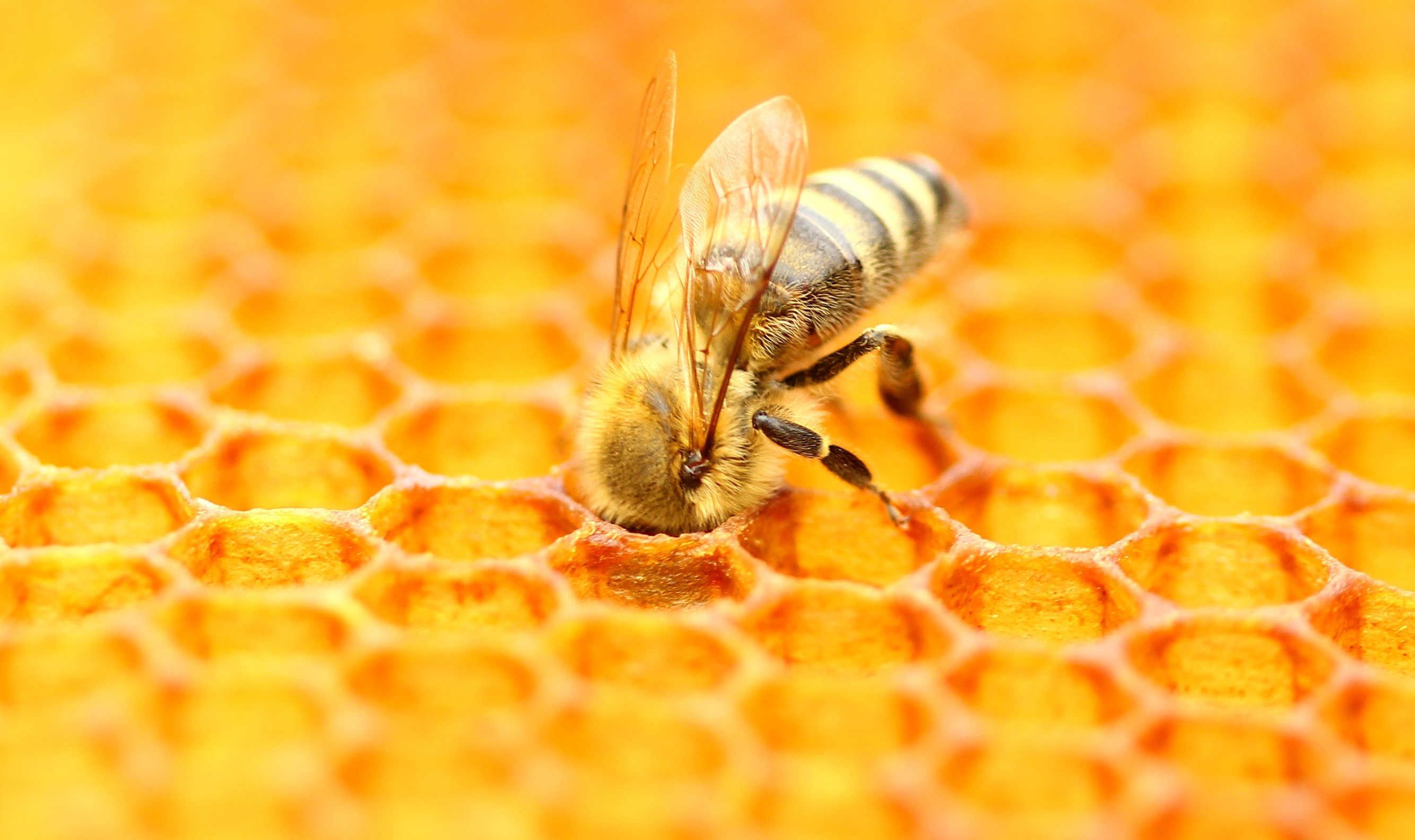For a few millennia, mankind has used honey as food and a healing agent without knowing how it worked. But, through experimentation, scientists have discovered that honey is a very complex substance. And today, we know that some of the components of honey that helps it be so effective at fighting disease are antibacterial factors.

Humans discovered the sweet powers of honey a few millennia ago. Paintings originating in the Middle Stone Age, 8,000 years ago, show humans collecting honey among bees. Romans ate honey to treat gut diseases. In ancient Egypt, honey was often used in combination with grease and lint to treat wounds. Nowadays, just like our ancestors, we continue to use honey to sweeten our food and treat various ailments. You might recall a time when your mom gave you some honey to soothe your sore throat.
In 1962, studies done by Jonathan White et al. revealed honey contains the enzyme glucose oxidase, which produces gluconic acid and the antimicrobial hydrogen peroxide, the antiseptic that doctors recommend for cuts and scrapes to inhibit bacterial growth. Yes! Honey can make hydrogen peroxide in the presence of a little water. In fact, honeybees add glucose oxidase to the collected nectar during honey production. This addition helps establish a low pH (3.5-4.5) and prevents bacterial growth, resulting in the preservation of honey.
It’s not just this one enzyme that gives honey its magic. A study done by Chirife et al. in 1983 suggests that the sugar in honey contributes to its antimicrobial activity. The supersaturation of honey with high sugar content means that there is very little water available for any organism to consume and thrive. Since bacteria need water to survive, the low amounts of water in honey makes it an effective antibacterial substance.
Not all honey is made the same, however. Not long ago, scientists found that Manuka honey, derived from the Manuka tree (Leptospermum scoparium) found in New Zealand, contains a very powerful antibacterial compound. In 2008, Elvira Mavric and her team studied 50 different samples of honey, including six New Zealand Manuka samples. They found that Manuka honey contained 100-fold higher amounts of the phytochemical methylglyoxal (MGO), compared to other honey. MGO is a powerful compound capable of killing cells that form from dihydroxyacetone (DHA) present in the nectar of L. scoparium flowers.

Manuka Trees near Queen Charlotte Sound, New Zealand
What’s more important about their findings is that unlike dilution of other types of honey, diluted Manuka honey effectively killed E. coli. MGO in honey is especially effective in inhibiting growth of S. aureus, the bacterium that can cause minor skin infections and serious diseases such as pneumonia and meningitis.
Pair the antimicrobial aspects of honey with technology, and researchers are able to produce medical-grade honey, used specifically for wound care. This type of honey is generated by sterilizing raw honey with gamma irradiation to destroy any bacterial spores that if left in the honey, may cause wound botulism or gangrene. Nowadays, the main medical-grade honeys used are Manuka honey and Revamil, a honey produced through a standard process in greenhouses.
Medical-grade honey has also been very useful in uncovering the factors that make honey a potent killer of bacteria. Paulus Kwakman and his team studied the “unknown bactericidal factors” in unprocessed Revamil honey. They found that unlike Manuka honey, Revamil contains the antimicrobial peptide (AMP) bee defensin-1, also called royalisin. Bee defensin-1 was first identified in honeybee blood (hemolymph) as food for queen bee larvae. Kwakman et al. showed bee defensin-1 in honey has strong antibacterial activity against Gram-positive bacteria including B. subtilis, methicillin-resistant S. aureus, and Paenibacillus larvae, which causes a devastating bee larval disease. And, just last year, Marcela Bucekova and her research team published their studies showing how bee defensin-1 stimulated wound closure in vitro and promoted re-epithelisation in uninfected excision wounds in rats.
Now that we live in an age when organisms are becoming resistant to commonplace antibiotics and emerging “superbugs,” the medical and scientific communities are recognizing the healing potential of honey. For example, S. aureus is one bacterium that people carry, and it can cause many diseases. In the mid-twentieth century, however, S. aureus became resistant to methicillin, an antibiotic close to penicillin, giving rise to the superbug MRSA. We know that MRSA is found in (colonizes) the nose tissue of about two in 100 individuals, where it usually does not cause disease. But, if the colonized skin is injured, MRSA could enter the body and cause an infection leading to devastating skin destruction and death. This is why MRSA is called “flesh-eating bacterium.”
Actually, Toney Poovelikunnel and his team discovered very recently that medical-grade honey is able to eliminate (decolonize) MRSA from the nose of patients. In this clinical study, Poovelikunnel and his team applied medical-grade honey to the anterior nares (the external part of the nostrils) with a cotton swab, three times a day for five consecutive days. They learned that, medical-grade honey has a decolonization rate of 42.8%, similar to that of mupirocin, a topical agent frequently used to decolonize MRSA from the anterior nares. Who would have thought, honey can fight the dreaded MRSA superbug?
These studies certainly indicate that honey can help us fight antibiotic resistance. And, while we continue to discover new ways in which honey can combat dangerous bacteria, we now have a better understanding of the mechanisms behind honey’s healing powers.
References
Boukraâ, L. (2013). Honey in traditional and modern medicine. Boca Raton, FL: CRC Press. doi:10.1201/b15608.
Bucekova, M., Sojka, M., Valachova, I., Martinotti, S., Ranzato, E., Szep, Z., . . . Majtan, J. (2017). Bee-derived antibacterial peptide, defensin-1, promotes wound re-epithelialisation in vitro and in vivo. Scientific Reports, 7(1). doi:10.1038/s41598-017-07494-0.
Cooper, R., Molan, P., & Harding, K. (2002). The sensitivity to honey of Gram-positive cocci of clinical significance isolated from wounds. Journal of Applied Microbiology, 93(5), 857-863. doi:10.1046/j.1365-2672.2002.01761.x.
Dams, L. R. (1978). Bees and Honey-Hunting Scenes in the Mesolithic Rock Art of Eastern Spain. Bee World, 59(2), 45-53. doi:10.1080/0005772x.1978.11097692.
Ghalioungui, P. (1987). The Ebers papyrus: A new English translation, commentaries and glossaries. Cairo: Academy of Scientific Research and Technology.
Henriques, A. F., Jenkins, R. E., Burton, N. F., & Cooper, R. A. (2010). The effect of Manuka honey on the structure of Pseudomonas aeruginosa. European Journal of Clinical Microbiology & Infectious Diseases, 30(2), 167-171. doi:10.1007/s10096-010-1065-1.
Kwakman, P., Akker, J. V., Güçlü, A., Aslami, H., Binnekade, J., Boer, L. D., . . . Zaat, S. (2008). Medical‐Grade Honey Kills Antibiotic‐Resistant Bacteria In Vitro and Eradicates Skin Colonization. Clinical Infectious Diseases, 46(11), 1677-1682. doi:10.1086/587892.
Kwakman, P. H., Velde, A. A., Boer, L. D., Speijer, D., Vandenbroucke-Grauls, C. M., & Zaat, S. A. (2010). How honey kills bacteria. The FASEB Journal, 24(7), 2576-2582. doi:10.1096/fj.09-150789.
Kwakman, P. H., & Zaat, S. A. (2011). Antibacterial components of honey. IUBMB Life, 64(1), 48-55. doi:10.1002/iub.578.
Mavric, E., Wittmann, S., Barth, G., & Henle, T. (2008). Identification and quantification of methylglyoxal as the dominant antibacterial constituent of Manuka (Leptospermum scoparium) honeys from New Zealand. Molecular Nutrition & Food Research, 52(4), 483-489. doi:10.1002/mnfr.200700282.
Poovelikunnel, T., Gethin, G., Solanki, D., Mcfadden, E., Codd, M., & Humphreys, H. (2018). Randomized controlled trial of honey versus mupirocin to decolonize patients with nasal colonization of methicillin-resistant Staphylococcus aureus. Journal of Hospital Infection, 98(2), 141-148. doi:10.1016/j.jhin.2017.10.016.
White, J. W., Subers, M. H., & Schepartz, A. I. (1963). The identification of inhibine, the antibacterial factor in honey, as hydrogen peroxide and its origin in a honey glucose-oxidase system. Biochimica Et Biophysica Acta (BBA) - Specialized Section on Enzymological Subjects, 73(1), 57-70. doi:10.1016/0926-6569(63)90108-1.
Fernanda Ruiz is a science content writer at Gold Biotechnology. She holds a bachelor's of science in biology from St. Mary's University and a PhD in molecular biology from Baylor College of Medicine.
Categories: 79101





